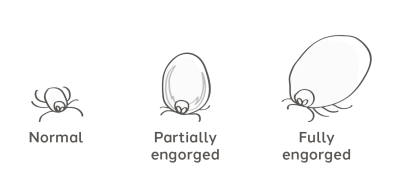Ticks
Does your pet have a tick?
Check your pet regularly for ticks, especially in the Spring and Autumn. They feed on blood and can cause nasty infections in you and your pet.
They are commonly found in woodland, grassland and heath areas, especially in areas where there are lots of sheep and deer.
They don't fly or jump but climb onto your pet's coat as they walk past then attach and feed on their blood.
WHAT YOU MAY SEE
Ticks can look very different depending on their species and age and how filled with blood they are.
They are spider like and egg shaped with 8 legs.
They are often whitish but get darker as they fill with blood.

HOW TO REMOVE TICKS
- Put gloves on.
- Choose the most suitable remover for the size of the tick.
- Carefully slide it underneath the tick.
- Rotate remover a couple of times and the tick should detach itself.

TIPS
- Don’t squeeze a tick’s body or allow the head parts to get stuck inside your pet (this increases the risk of infection).
- Check you have removed the whole tick.
- If you want to save the tick to send to Public Health England surveillance scheme, place in a sealed plastic bag and store in the freezer and contact them for instructions.
- If not, place it in tissue and squash it then flush it down the toilet.
- Disinfect the bite site with the iodine prep pad in your kit.
- Monitor the bite site for the next couple of weeks for signs of infection and monitor the health of your pet.
- Speak to your vet about tick prevention products or if concerned about a tick bite.



